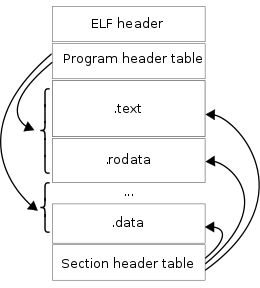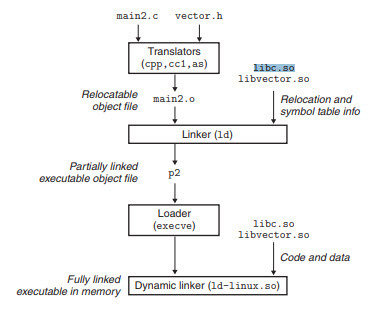ELF & Linking
ELF Header
#define EI_NIDENT 16
typedef struct {
unsigned char e_ident[EI_NIDENT];
Elf32_Half e_type;
Elf32_Half e_machine;
Elf32_Word e_version;
Elf32_Addr e_entry;
Elf32_Off e_phoff;
Elf32_Off e_shoff;
Elf32_Word e_flags;
Elf32_Half e_ehsize;
Elf32_Half e_phentsize;
Elf32_Half e_phnum;
Elf32_Half e_shentsize;
Elf32_Half e_shnum;
Elf32_Half e_shtrndx;
} Elf32_Ehdr;$ readelf -h a.out ###Output modified slightly
Magic: 7f 45 4c 46 \x7fELF
Class: ELF32
Data: little endian
Version: 1 (current)
OS/ABI: UNIX - System V
ABI Version: 0
Type: EXEC
Machine: Intel 80386
Version: 0x1
Entry point address: 0x8048430
Start of program headers: 52
Start of section headers: 8588
Flags: 0x0
Size of this header: 52 (bytes)
Size of program headers: 32 (bytes)
Number of program headers: 9
Size of section headers: 40 (bytes)
Number of section headers: 35
Section header string table index: 34
e_ -- elf
ph -- program header
sh -- section header
off -- offset
ent -- entry
e_shentsize ?
e_shnum ?
e_phentsize ?
e_shtrndx ?*
Section Header Entry Size
Section Header Number (of entries)
Program Header Entry Size
Section Header String Table Index
Section Header
TRY:
$ readelf -S /bin/bash
### modified output
[Nr] Name Type
[ 0] NULL
[ 1] .interp PROGBITS
[ 2] .note.ABI-tag NOTE
[ 3] .note.gnu.build-i NOTE
[ 4] .gnu.hash GNU_HASH
[ 5] .dynsym DYNSYM
[ 6] .dynstr STRTAB
[ 7] .gnu.version VERSYM
[ 8] .gnu.version_r VERNEED
[ 9] .rela.dyn RELA
[10] .rela.plt RELA
[11] .init PROGBITS
[12] .plt PROGBITS
[13] .plt.got PROGBITS
[14] .text PROGBITS
[15] .fini PROGBITS
[16] .rodata PROGBITS
[17] .eh_frame_hdr PROGBITS
[18] .eh_frame PROGBITS
[19] .init_array INIT_ARRAY
[20] .fini_array FINI_ARRAY
[21] .data.rel.ro PROGBITS
[22] .dynamic DYNAMIC
[23] .got PROGBITS
[24] .data PROGBITS
[25] .bss NOBITS
[26] .gnu_debuglink PROGBITS
[27] .shstrtab STRTAB What is a section header?
What are some sections that are useful to us?
.text
.got
.data
A well defined header that gives information on a section of the binary which is unstructured.
Program Header
Program headers indicates how segments required for execution are to be loaded into virtual memory.
There exists a Sections to Segment mapping that specifies which sections are part of which segments.
Most disassemblers recreated the does all analysis based on virtual addressing

Binary Layout
Does it matter where the Program and Section headers are in the binary?
Where must the ELF Header always exist?
Are all Section or Program headers needed?

How do multiple source files become a single executable?
ELF file formats:
- Executable file
- Shared Object file
- Relocatable file
- and some others
ELF Header specifies the file format
+ Executable: specifies how to load the program into a process image (remember exec and forking?)
+ Relocatable: specifies how to include it's own code and data into an Executable or Shared object. Object files waiting to be included.
+ Shared Object: Dynamic library that links with an executable on load by a linker. Think printf, Libc, stdio.h
How do multiple source files become a single executable?
ELF file formats:
- Executable file
- Shared Object file
- Relocatable file


Linker links objects with shared libraries.
What does the whole pipeline look like then?
1. GCC compiles into ELF Relocatables
2. Static linker links Relocatables and attaches necessary information for Shared Object linking into an Executable
3. Loader execs the Executable, then the dynamic linker actually links to the Shared Objects for code execution.
